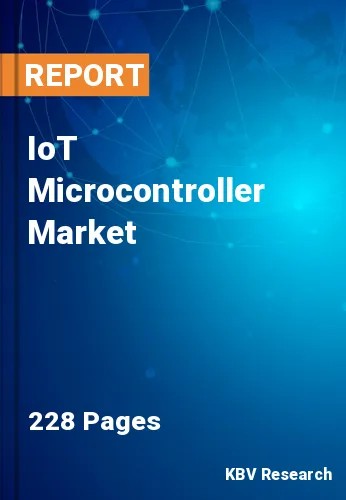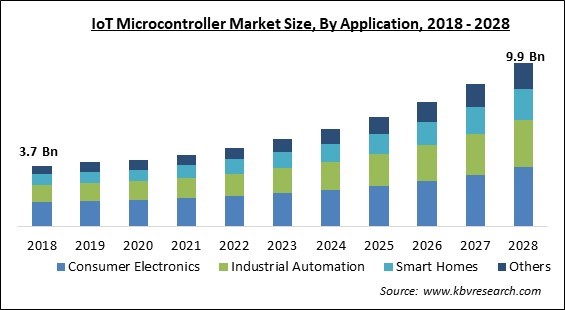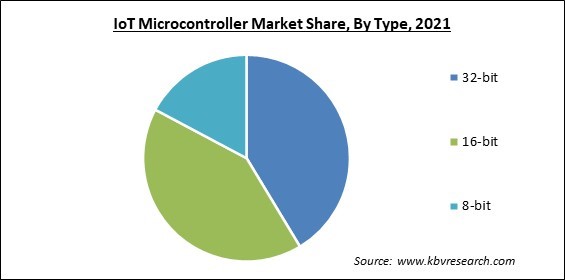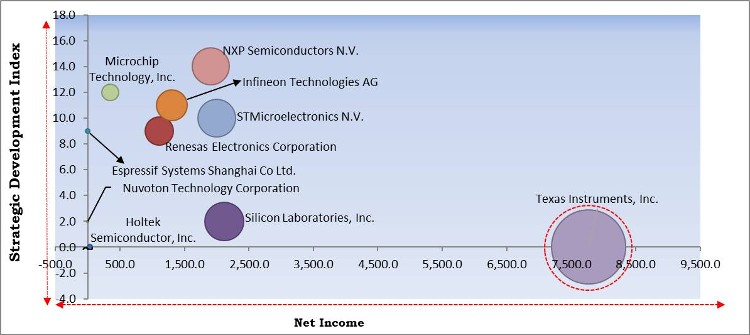
The Global IoT Microcontroller Market size is expected to reach $9.9 billion by 2028, rising at a market growth of 13.0% CAGR during the forecast period.
A microcontroller is a sort of processor that combines memory, CPU, and input/output peripherals into a single integrated circuit. Microcontrollers can be found in office machinery, remote controls, household power tools, appliances, toys, and a variety of other embedded systems that are automatically controlled. Microcontroller technology ensures that electronic equipment are managed smoothly as well as they significantly eliminate errors. Microcontrollers are anticipated to gain popularity in the communication, automotive, retail, and other industries as a result of the advantages of this technology. Consumer products, automotive market growth, and increased acceptance of innovative technologies like touch screens and timers, among other things, are majorly contributing to the IoT microcontroller market's growth.
Microcontrollers, often called microcontroller units (MCUs), are miniaturized computers with processing capability. The computing capability of smart connected devices and IoT is determined by these units. Microcontrollers are now used in a wide range of IoT products and devices, including consumer electronics, power tools, smart automotive engine controls, office equipment, medical devices, and a slew of other applications. Home automation, industrial automation, smart appliances, smart cities, smart grids, and other applications are all seeing rapid adoption of the Internet of Things. The development of high-performance microcontrollers is becoming increasingly crucial as the number of connected systems and devices grows around the world.
With the growing significance of interconnectivity, the Internet of Things is gaining traction and demand in various industries. A memory, a core processor, and programmable input and output peripherals make up an SoC, or, system-on-chip. For improved performance, a small component of a random-access memory is also included in a microcontroller in many circumstances. In addition, blood glucose monitors, wearable heart rate monitors, and retinal implants also utilize IoT microcontroller-integrated devices with lower battery capacities to monitor patients through wireless technologies for ultimate transfer to storage based on the cloud or on any connected device, such as smartphones, laptops, and tablets. Because of their low power consumption, MCU-embedded analog peripheral devices are becoming increasingly popular, opening up new avenues for the ultra-low-power microcontroller market.

The COVID-19 led the world to a very critical environment in terms of economy and healthcare. Many businesses were demolished due to the advent of this pandemic. In addition, the COVID-19 pandemic also caused a significant inconvenience in the day-to-day life of people across the world. The major factor that led the market to a downfall was the lockdown that was enforced by the government with the purpose to regulate the diffusion of the infection. Due to the lockdown, the manufacturing units of various goods, including retail cooler, went under a temporary closure. The supply chain of the product was substantially hampered.
The demand for the 32-bit microcontroller is constantly increasing in various healthcare facilities all over the world. Numerous medical applications of the 32-bit microcontroller are employing 32-bit microcontrollers in comparison to others. 32-bit microcontroller refers to the microcontroller, which comprises the ability to handle 32-bit value arithmetic operation. These type of microcontrollers uses lesser instruction cycles to implement a function due to their broader data bus. When compared to other MCUs on the market, 32-bit Microcontroller Units give various intuitive advantages like high scalability, low power consumption, as well as higher Input/Output peripherals with a reduced size. It can do high-end operations with great accuracy and reduced computational cycles, making it more suitable for use in high-precision healthcare and medical devices.
Microcontrollers are utilized in a variety of vehicle electronics, including in-vehicle infotainment, instrument clusters, systems, telematics, and modern safety systems. The penetration of MCUs across the automotive market will be boosted by rising trends of AI-enabled voice assistance, Advanced driver assistance development, and self-driving cars by key automotive OEMs. To achieve a competitive advantage in the market, companies are working heavily on developing automotive-grade MCUs with enhanced functionality. Moreover, the demand for luxury vehicles is constantly surging due to the rising disposable income of people all over the world. IoT microcontrollers are substantially being used in the industrial automation sector to facilitate various industrial processes.
The IoT microcontroller industry is tremendously rising due to a variety of factors and an increasing number of applications. However, there are certain barriers that are hindering the demand for IoT microcontrollers. One of the major drawbacks of IoT controllers is the complications in the designing and development of these devices. Design complexity in high-speed as well as power-critical applications can majorly impede the production of IoT microcontrollers. As a result, manufacturers are spending significant amounts in R&D to develop cutting-edge microcontrollers. Due to the higher investment in these research and development activities, a considerable number of small and medium organizations would become unable to employ IoT microcontrollers.

Based on Type, the market is segmented into 32-bit, 16-bit, and 8-bit. In 2021, the 8-bit segment witnessed a significant revenue share of the IoT microcontrollers market. 8-bit microcontrollers are extensively being utilized for low-power applications such as smart wearables and connected devices. The growing preference for fitness wearables, particularly among millennials, is expected to drive the adoption of wearables. Lifestyle disorders, such as obesity, prompt individuals to pursue various fitness-related activities and monitor their performance using wearables, which is expected to propel the market growth of the segment over the forecasting years.
Based on Application, the market is segmented into Consumer Electronics (Smartphones, Wearables, and Others), Industrial Automation, Smart Homes, and Others. In 2021, the consumer electronic segment procured the largest revenue share of the IoT microcontrollers market. The consumer electronics segment encompasses smartphones, wearables, and others. The COVID-19 outbreak compelled the employees to work remotely. This has further triggered the demand for smart wearables such as smartwatches and fitness trackers. Increasing fitness and health awareness among millennials is also likely to spur wearables sales, which is expected to continue in the near future. Therefore, the adoption of low-power MCUs coupled with short-range wireless connectivity, especially 8-bit integrated with Bluetooth/KNX/Zigbee/Wi-Fi-based protocols, is expected to drive the IoT MCUs sales over the forecast period.
| Report Attribute | Details |
|---|---|
| Market size value in 2021 | USD 4.3 Billion |
| Market size forecast in 2028 | USD 9.9 Billion |
| Base Year | 2021 |
| Historical Period | 2018 to 2020 |
| Forecast Period | 2022 to 2028 |
| Revenue Growth Rate | CAGR of 13% from 2022 to 2028 |
| Number of Pages | 228 |
| Number of Tables | 363 |
| Report coverage | Market Trends, Revenue Estimation and Forecast, Segmentation Analysis, Regional and Country Breakdown, Competitive Landscape, Companies Strategic Developments, Company Profiling |
| Segments covered | Type, Application, Region |
| Country scope | US, Canada, Mexico, Germany, UK, France, Russia, Spain, Italy, China, Japan, India, South Korea, Singapore, Malaysia, Brazil, Argentina, UAE, Saudi Arabia, South Africa, Nigeria |
| Growth Drivers |
|
| Restraints |
|
Based on Regions, the market is segmented into North America, Europe, Asia Pacific, and Latin America, Middle East & Africa. In 2021, the Asia-Pacific accounted for the largest revenue share of the IoT microcontrollers market. The increasing growth of the market is primarily driven by China, India, and Japan which accounted for considerable sales across the region. This can be ascribed to increasing demand for smart wearables and favorable government spending to promote smart cities initiatives. The recent Regional Comprehensive Economic Partnership trade agreement with China and ASEAN countries coupled with the increase in disposable income among emerging economies such as Vietnam, Malaysia, and Indonesia are expected to develop affordable smart home devices among the consumers, which would eventually drive the market growth.
Free Valuable Insights: Global IoT Microcontroller Market size to reach USD 9.9 Billion by 2028

The major strategies followed by the market participants are Product Launches. Based on the Analysis presented in the Cardinal matrix; Texas Instruments, Inc. is the major forerunner in the IoT Microcontroller Market. Companies such as STMicroelectronics N.V., Infineon Technologies AG, NXP Semiconductors N.V. are some of the key innovators in the Market.
The market research report covers the analysis of key stake holders of the market. Key companies profiled in the report include Silicon Laboratories, Inc., Espressif Systems Shanghai Co Ltd., Holtek Semiconductor, Inc., Renesas Electronics Corporation, STMicroelectronics N.V., Infineon Technologies AG, Texas Instruments, Inc., NXP Semiconductors N.V., Nuvoton Technology Corporation, and Microchip Technology, Inc.
By Type
By Application
By Geography
The IoT microcontroller market size is projected to reach USD 9.9 billion by 2028.
Increasing adoption of 32-bit microcontrollers across healthcare and medical devices are increasing are driving the market in coming years, however, complexities in designing cutting-edge IoT microcontrollers growth of the market.
Silicon Laboratories, Inc., Espressif Systems Shanghai Co Ltd., Holtek Semiconductor, Inc., Renesas Electronics Corporation, STMicroelectronics N.V., Infineon Technologies AG, Texas Instruments, Inc., NXP Semiconductors N.V., Nuvoton Technology Corporation, and Microchip Technology, Inc.
The expected CAGR of the IoT microcontroller market is 13% from 2022 to 2028.
The 32-bit segment acquired maximum revenue share in the Global IoT Microcontroller Market by Type in 2021, and would achieve a market value of $4.5 billion by 2028.
The Asia Pacific is the fastest growing region in the Global IoT Microcontroller Market by Region in 2021, and would continue to be a dominant market till 2028.
Our team of dedicated experts can provide you with attractive expansion opportunities for your business.
